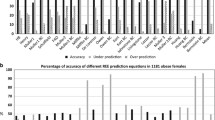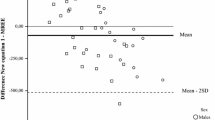Abstract
The aims of the present study were to develop and cross-validate new equations for predicting resting energy expenditure (PREE) in severely obese Italian women, and to compare their accuracy with those of the Harris-Benedict, Bernstein, WHO/FAO/UNU, Owen, Mifflin, Nelson, Siervo, Huang and Livingston equations to predict REE, using the Bland-Altman method. One hundred and eighty two women [mean body mass index (BMI) 45.6 kg/m2; 56.7% fat mass (FM)], aged 19 to 60 yr participated in this study. REE was measured by indirect calorimetry and body composition by bioelectrical analysis. Equations were derived by stepwise multiple regression analysis, using a calibration group and tested against the validation group. Two new specific equations based on anthropometric REE=Weigh tx0.042+Heightx3.619-2.678 (R2=0.66, SE=0.56 MJ) or body composition parameters REE=FF Mx0.067+FMx0.046+1.568 (R2=0.63, SE=0.58 MJ) were generated. Mean PREE were no different from the mean measured resting energy expenditure (MREE) (<1%, p>0.800) and REE was predicted accurately (95–105% of MREE) in 60% of subjects. The WHO/FAO/UNU, Harris-Benedict and Siervo equations showed mean differences <2% and PREE was accurate in <44% of subjects. The Huang, Mifflin and Livingston equations showed a mean PREE underestimation (>5.0%, p<0.001) and PREE was accurate in <38% of subjects. The Owen, Bernstein and Nelson equations showed a greater PREE underestimation (>14%, p<0.001 ) in >90% of subjects. The new prediction equations allow an accurate estimation of REE in groups of severely obese women and result in lower mean differences and lower limits of agreement between PREE and MREE than commonly used equations.
Similar content being viewed by others
References
WHO/FAO/UNU. Obesity: Preventing and Managing the Global Epidemic: Report of a WHO consultation on obesity. Geneva, Switzerland: World Health Organization, 1998.
Ford ES, Giles WH, Dietz WH. Prevalence of the metabolic syndrome among US adults: findings from the third National Health and Nutrition Examination Survey. JAMA 2002, 287: 356–9.
Bongain A, Isnard V, Gillet JY. Obesity in obstetrics and gynaecology. EurJ Obstet Gynecol Reprod Biol 1998, 77: 217–28.
Ramsay JE, Ferrell WR, Crawford L, et al. Maternal obesity is associated with dysregulation of metabolic, vascular, and inflammatory pathways. J Clin Endocrinol Metab 2002, 87: 4231–7.
Foster GD, McGuckin BG. Estimating resting energy expenditure in obesity. Obes Res 2001, 9(Suppl 5): 367S–72S; discussion 373S-374S.
Harris JA, Benedict FG. A biometric study of basal metabolism in man. Washington, DC: Carnegie Institute of Washington. 1919.
Bernstein RS, Thornton JC, Yang MU, et al. Prediction of the resting metabolic rate in obese patients. Am J Clin Nutr 1983, 37: 595–602.
WHO/FAO/UNU. Energy and protein requirements: report of joint FAO/WHO/UNU expert consultation World Health Organ Technical Report Series 724. Geneva, Switzerland, 1985.
Owen OE, Kavle E, Owen RS, et al. A reappraisal of caloric requirements in healthy women. Am J Clin Nutr 1986, 44: 1–19.
Mifflin MD, St Jeor ST, Hill LA, et al. Anew predictive equation for resting energy expenditure in healthy individuals. Am J Clin Nutr 1990, 51: 241–7.
Nelson KM, Weinsier RL, Long CL, Schutz Y. Prediction of resting energy expenditure from fat-free mass and fat mass. Am J Clin Nutr 1992, 56: 848–56.
Siervo M, Boschi V, Falconi C. Which REE prediction equation should we use in normal-weight, overweight and obese women? Clin Nutr 2003, 22: 193–204.
Huang KC, Kormas N, Steinbeck K, Loughnan G, Caterson ID. Resting metabolic rate in severely obese diabetic and nondiabetic subjects. Obes Res 2004, 12: 840–5.
Livingston EH, Kohlstadt I. Simplified resting metabolic ratepredicting formulas for normal-sized and obese individuals. Obes Res 2005, 13: 1255–62.
Sempé M, Pedron G, Roy-Pernot M-P. Auxologie méthode et séquences. Paris: Laboratoire Théraplix. 1979.
Lukaski HC, Bolonchuk WW, Hall CB, Siders WA. Validation of tetrapolar bioelectrical impedance method to assess human body composition. J Appl Physiol 1986, 60: 1327–32.
Das SK, Roberts SB, Kehayias JJ, et al. Body composition assessment in extreme obesity and after massive weight loss induced by gastric bypass surgery. Am J Physiol Endocrinol Metab 2003, 284: E1080–8.
de Weir JB. New methods for calculating metabolic rate with special references to protein metabolism. J Physiol (Lond) 1949, 109: 1–9.
Bland JM, Altman DG. Statistical methods for assessing agreement between two methods of clinical measurement. Lancet 1986, 1: 307–10.
Phang PT, Rich T, Ronco J. A validation and comparison study of two metabolic monitors. J Parenteral Enteral Nutr 1990, 14: 259–61.
Karhunen L, Franssila-Kallunki A, Rissanen A, et al. Determinants of resting energy expenditure in obese non-diabetic caucasian women. Int J Obes Relat Metab Disord 1997, 21: 197–202.
Miller AT Jr, Blyth CS. Lean body mass as a metabolic reference standard. J Appl Physiol 1953, 5: 311–6.
Horgan GW, Stubbs J. Predicting basal metabolic rate in the obese is difficult. EurJ Clin Nutr 2003, 57: 335–40.
Prentice AM, Black AE, Coward WA, et al. High levels of energy expenditure in obese women. Br Med J (Clin Res Ed) 1986, 292: 983–7.
Leibel RL, Rosenbaum M, Hirsch J. Changes in energy expenditure resulting from altered body weight. N Engl J Med 1995, 332: 621–8.
Frankenfield DC, Rowe WA, Smith JS, Cooney RN. Validation of several established equations for resting metabolic rate in obese and nonobese people. J Am Diet Assoc 2003, 103: 1152–9.
Feurer ID, Crosby LO, Buzby GP, Rosato EF, Mullen JL. Resting energy expenditure in morbid obesity. Ann Surg 1983, 197: 17–21.
Author information
Authors and Affiliations
Corresponding author
Rights and permissions
About this article
Cite this article
Lazzer, S., Agosti, F., Silvestri, P. et al. Prediction of resting energy expenditure in severely obese Italian women. J Endocrinol Invest 30, 20–27 (2007). https://doi.org/10.1007/BF03347391
Accepted:
Published:
Issue Date:
DOI: https://doi.org/10.1007/BF03347391




